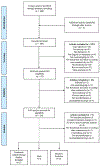Neurocircuitry of treatment in anxiety disorders
- PMID: 35756886
- PMCID: PMC9222661
- DOI: 10.1016/j.bionps.2022.100052
Neurocircuitry of treatment in anxiety disorders
Abstract
Background: Understanding how treatments change neurobiology is critical to developing predictors of treatment response. This is especially true for anxiety disorders-the most common psychiatric disorders across the lifespan. With this in mind, we examined neurofunctional predictors of treatment response and neurofunctional changes associated with treatment across anxiety disorders.
Methods: PubMed/Medline was searched for prospective treatment studies that included parallel examinations of functional activation or connectivity (both task-based and resting state) in adults and youth with panic disorder and generalized, separation, and/or social anxiety disorders published before April 30, 2021. All studies examining baseline predictors or changes related to pharmacologic and psychotherapeutic treatment of DSM-TV and DSM-5 anxiety disorders were included. Demographic, clinical, and treatment data as well as neurofunctional outcomes were extracted and summarized.
Results: Twenty-nine studies examined changes in functional activation and/or connectivity (56 treatment arms) related to treatment and twenty-three examined neurofunctional predictors of treatment response. Predictors of treatment response and treatment-related neurofunctional changes were frequently observed within amygdala-prefrontal circuits. However, immense heterogeneity and few replication studies preclude a cohesive neurofunctional treatment response model across anxiety disorders.
Conclusions: The extant literature describing neurofunctional aspects of treatment response in anxiety disorders is best viewed as a partially constructed scaffold on which to build a clinically translatable set of robust neuroimaging biomarkers that can be used to guide treatment and to select from available treatment. The construction of this understanding will require harmonization of analytic and task approaches, larger samples, and replication of component studies.
Keywords: Anxiety/Anxiety disorders; CBT/cognitive behavior; Pharmacotherapy; biological markers; neuroimaging; therapy; treatment.
Figures
Similar articles
-
Neurobiology of Treatment in Pediatric Anxiety Disorders.Child Adolesc Psychiatr Clin N Am. 2023 Jul;32(3):589-600. doi: 10.1016/j.chc.2023.02.005. Epub 2023 Mar 21. Child Adolesc Psychiatr Clin N Am. 2023. PMID: 37201969 Review.
-
Resting state amygdala-prefrontal connectivity predicts symptom change after cognitive behavioral therapy in generalized social anxiety disorder.Biol Mood Anxiety Disord. 2014 Dec 9;4(1):14. doi: 10.1186/s13587-014-0014-5. eCollection 2014. Biol Mood Anxiety Disord. 2014. PMID: 25540682 Free PMC article.
-
Neural Markers of Treatment Response in Pediatric Anxiety and PTSD.Curr Top Behav Neurosci. 2024 Dec 14:10.1007/7854_2024_547. doi: 10.1007/7854_2024_547. Online ahead of print. Curr Top Behav Neurosci. 2024. PMID: 39673034
-
Greater Dynamic and Lower Static Functional Brain Connectivity Prospectively Predict Placebo Response in Pediatric Generalized Anxiety Disorder.J Child Adolesc Psychopharmacol. 2020 Dec;30(10):606-616. doi: 10.1089/cap.2020.0024. Epub 2020 Jul 24. J Child Adolesc Psychopharmacol. 2020. PMID: 32721213 Free PMC article.
-
Neuroimaging in social anxiety disorder—a meta-analytic review resulting in a new neurofunctional model.Neurosci Biobehav Rev. 2014 Nov;47:260-80. doi: 10.1016/j.neubiorev.2014.08.003. Epub 2014 Aug 11. Neurosci Biobehav Rev. 2014. PMID: 25124509 Review.
Cited by
-
Alleviating anxiety and taming trauma: Novel pharmacotherapeutics for anxiety disorders and posttraumatic stress disorder.Neuropharmacology. 2023 Mar 15;226:109418. doi: 10.1016/j.neuropharm.2023.109418. Epub 2023 Jan 6. Neuropharmacology. 2023. PMID: 36623804 Free PMC article. Review.
-
Functional connectivity during tic suppression predicts reductions in vocal tics following behavior therapy in children with Tourette syndrome.Psychol Med. 2023 Dec;53(16):7857-7864. doi: 10.1017/S0033291723001940. Epub 2023 Jul 24. Psychol Med. 2023. PMID: 37485677 Free PMC article. Clinical Trial.
-
Psychological Outcomes and Mechanisms of Mindfulness-Based Training for Generalised Anxiety Disorder: A Systematic Review and Meta-Analysis.Curr Psychol. 2023 May 11:1-23. doi: 10.1007/s12144-023-04695-x. Online ahead of print. Curr Psychol. 2023. PMID: 37359641 Free PMC article.
-
Neurostructural, Neurofunctional, and Clinical Features of Chronic, Untreated Schizophrenia: A Narrative Review.Schizophr Bull. 2025 Mar 14;51(2):366-378. doi: 10.1093/schbul/sbae152. Schizophr Bull. 2025. PMID: 39212651 Free PMC article.
-
Longitudinal development of resting-state functional connectivity in adolescents with and without internalizing disorders.Neurosci Appl. 2024;3:104090. doi: 10.1016/j.nsa.2024.104090. Epub 2024 Sep 24. Neurosci Appl. 2024. PMID: 39634556 Free PMC article.
References
-
- Abbafati C, Machado DB, Cislaghi B, Salman OM, Karanikolos M, McKee M, Zhu C, 2020. Global burden of 369 diseases and injuries in 204 countries and territories, 1990–2019: a systematic analysis for the global burden of disease study 2019. Lancet 396 (10258), 1204–1222. 10.1016/S0140-6736C20)30925-9. - DOI - PMC - PubMed
-
- Andreescu C, Sheu LK, Tudorascu D, Gross JJ, Walker S, Banihashemi L, Aizenstein H, 2015. Emotion reactivity and regulation in late-life generalized anxiety disorder: functional connectivity at baseline and post-treatment. Am. J. Geriatr. Psychiatry 23 (2), 200–214. 10.1016/j.jagp.2014.05.003. - DOI - PMC - PubMed
-
- Brown LA, Young KS, Goldin PR, Torre JB, Burklund LJ, Davies CD, Craske MG, 2019. Self-referential processing during observation of a speech performance task in social anxiety disorder from pre- to post-treatment: evidence of disrupted neural activation. Psychiatry Res. Neuroimaging 284 (November), 13–20. 10.1016/j.pscychresns.2018.12.017. - DOI - PMC - PubMed
Grants and funding
LinkOut - more resources
Full Text Sources
Miscellaneous

